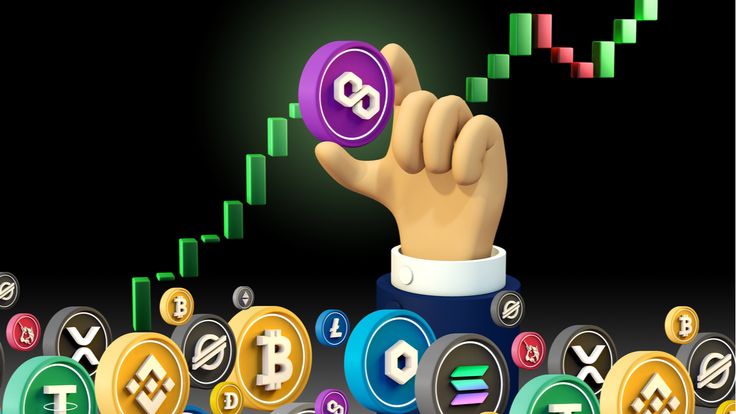Introduction: Polygon (MATIC)
Polygon (MATIC) is a scaling solution for the Ethereum blockchain, designed to improve the performance and usability of decentralized applications (dApps). Launched in 2017 by Jaynti Kanani, Sandeep Nailwal, and Anurag Arjun, Polygon aims to address Ethereum’s scalability issues by creating a multi-chain system that offers faster transactions, lower fees, and a more user-friendly experience.
Polygon provides developers with the tools needed to build decentralized applications while benefiting from the security and network effects of Ethereum. With its growing ecosystem of projects, strategic partnerships, and strong support within the blockchain community, Polygon (MATIC) has quickly gained recognition as a key player in the blockchain space.
In this article, we will explore the history, functionality, and significance of Polygon, its impact on the blockchain ecosystem, and why it’s considered a game-changer in decentralized finance (DeFi), gaming, and beyond.
What is Polygon (MATIC)?
Polygon (MATIC) is a layer 2 scaling solution for Ethereum, built to address Ethereum’s limitations, particularly its transaction throughput and high gas fees. Polygon aims to provide a more scalable and efficient framework for decentralized applications, offering faster transactions and a more seamless user experience.
Polygon (MATIC) uses a combination of sidechains, Plasma chains, and Rollups to scale Ethereum. These technologies work together to ensure that transactions are processed efficiently while still benefiting from the security of Ethereum’s main chain. Polygon’s multi-chain approach allows developers to build interoperable dApps that can seamlessly communicate with other blockchain ecosystems.
The native cryptocurrency of the Polygon network is MATIC, which is used for paying transaction fees, staking, and governance on the platform. MATIC plays a crucial role in securing the network and facilitating the growth of the ecosystem.
History of Polygon (MATIC)
Polygon (MATIC) was initially launched in 2017 under the name Matic Network. It started as a scaling solution for Ethereum, with a focus on making decentralized applications (dApps) faster and more accessible by addressing Ethereum’s scalability challenges.
In 2021, Matic Network rebranded as Polygon, expanding its scope beyond a single solution and transforming into a full-fledged multi-chain platform that supports a wide range of technologies and blockchain ecosystems. The rebranding marked a significant shift in Polygon’s mission, enabling it to offer solutions for a broader array of scaling and interoperability issues.
Polygon has since attracted numerous developers, projects, and partnerships in the blockchain space, helping establish its reputation as a leading solution for Ethereum’s scalability challenges. It is now one of the most popular and adopted scaling platforms in the blockchain industry.
How Polygon (MATIC) Works
Polygon (MATIC) aims to create a multi-chain ecosystem that connects different blockchain networks, allowing for seamless communication and interaction between them. Here’s how Polygon works to achieve its scalability and interoperability goals:
- Layer 2 Solution: Polygon operates as a Layer 2 scaling solution on top of Ethereum. It processes transactions off-chain (on secondary chains) and periodically settles them on Ethereum’s main chain. This reduces congestion, transaction fees, and improves speed.
- Sidechains and Plasma: Polygon uses a combination of sidechains and Plasma chains to scale Ethereum. Sidechains allow for faster transaction processing, while Plasma chains create scalable networks for decentralized applications. These solutions help to offload some of Ethereum’s workload while still maintaining its security.
- Polygon SDK: Polygon’s Software Development Kit (SDK) is a key feature that allows developers to build custom blockchains and decentralized applications on the platform. The SDK is highly flexible and can support multiple consensus models, enabling developers to choose the structure that best suits their project’s needs.
- Security and Validation: Polygon uses a Proof of Stake (PoS) consensus mechanism to ensure the security and integrity of the network. Validators on the network stake MATIC tokens to participate in consensus and earn rewards for verifying transactions.
- Interoperability: One of Polygon’s core goals is to ensure interoperability across different blockchain ecosystems. By allowing different blockchains to communicate and share data, Polygon facilitates cross-chain compatibility, enabling decentralized applications to interact seamlessly across multiple networks.
Daily Life Impacts of Polygon (MATIC)
Polygon (MATIC) has a tangible impact on the blockchain industry and the daily lives of users, particularly those who interact with decentralized applications. Here’s how Polygon influences daily life:
- Reduced Transaction Costs: Polygon helps reduce high Ethereum gas fees, making it more affordable for users to interact with dApps, trade tokens, and execute smart contracts. This is particularly important for users in decentralized finance (DeFi), where frequent transactions could lead to prohibitively high costs on Ethereum.
- Faster Transactions: Polygon allows for faster transaction processing, which makes it easier for users to send and receive cryptocurrency, interact with NFTs (Non-Fungible Tokens), and participate in DeFi applications without experiencing delays or network congestion.
- Better User Experience: With lower fees and faster transactions, users can enjoy a more seamless and smooth experience when interacting with blockchain applications. This helps increase adoption and participation in the growing ecosystem of decentralized applications.
- DeFi and Gaming Ecosystem: Polygon has become a go-to platform for DeFi projects, offering the infrastructure needed to run decentralized exchanges (DEXs), lending platforms, and yield farming protocols. Additionally, its scalability benefits are also extending to the gaming industry, where game developers are leveraging Polygon’s solutions for NFTs and in-game assets.
- Environmental Impact: Polygon’s PoS mechanism and energy-efficient design help reduce the environmental impact of blockchain operations, especially compared to proof-of-work systems like Bitcoin and Ethereum. This makes Polygon a more sustainable option for those concerned about the ecological impact of blockchain technology.
Fun Facts About Polygon (MATIC)
- Name Origin: The name “Polygon” was chosen to represent the multi-chain nature of the platform. A polygon is a geometric shape with multiple sides, symbolizing the many different chains that can connect to the Polygon network.
- Ethereum’s Scaling Champion: Polygon is widely regarded as the most effective scaling solution for Ethereum, helping the network handle more transactions and making Ethereum more accessible to users and developers.
- Growing Ecosystem: Polygon has established itself as a leader in the decentralized finance (DeFi) space, with numerous dApps and protocols migrating to its platform due to its faster transaction speeds and lower fees.
- Partnerships with Major Brands: Polygon has collaborated with several well-known brands, including Mark Cuban’s portfolio of companies, Adobe, and Aave. These partnerships demonstrate the platform’s growing influence and credibility in the blockchain space.
Frequently Asked Questions (FAQs)
- What is Polygon (MATIC)? Polygon is a scaling solution for Ethereum that improves transaction speed and reduces gas fees. It offers a multi-chain ecosystem that allows decentralized applications to be built more efficiently.
- How does Polygon (MATIC) work? Polygon works by offering a Layer 2 solution to Ethereum, using sidechains, Plasma chains, and Rollups to scale transactions while maintaining Ethereum’s security. The network is secured using a Proof of Stake (PoS) consensus mechanism.
- Why is Polygon important? Polygon is important because it helps solve scalability issues on Ethereum, making decentralized applications more efficient and accessible to users worldwide. It enables faster, cheaper, and more seamless blockchain interactions.
- What is the MATIC token used for? The MATIC token is used for transaction fees, staking, and network governance on the Polygon network. It also incentivizes validators and secures the platform.
- Is Polygon (MATIC) eco-friendly? Yes, Polygon uses a Proof of Stake (PoS) consensus mechanism, which is more energy-efficient compared to the Proof of Work (PoW) mechanism used by Ethereum and Bitcoin, making it a more environmentally friendly blockchain solution.
The Significance of Polygon (MATIC) to Society
Polygon (MATIC) is playing a crucial role in expanding the potential of decentralized finance (DeFi) and blockchain technology. By addressing Ethereum’s scalability problems, it is enabling a more inclusive, affordable, and efficient blockchain ecosystem. Polygon’s solutions also make blockchain applications more accessible to a broader audience, promoting widespread adoption of decentralized technologies.
In the long term, Polygon’s ability to scale Ethereum and integrate various blockchain ecosystems could drive more innovative solutions, such as tokenized assets, supply chain management, and smart city applications. As the blockchain industry continues to grow, Polygon is set to remain at the forefront of the scaling and interoperability movement, benefiting both developers and users worldwide.
Conclusion
Polygon (MATIC) is revolutionizing the way decentralized applications interact with blockchain technology by offering a scalable, affordable, and efficient solution to Ethereum’s challenges. With its multi-chain ecosystem, PoS security, and support for developers, Polygon is reshaping the blockchain landscape and opening the door for new innovations in DeFi, gaming, and beyond. As its ecosystem continues to expand, Polygon’s impact on the blockchain industry and society will only continue to grow, helping to bring about a more decentralized, transparent, and efficient future.











Perfect work you have done, this website is really cool with great info .